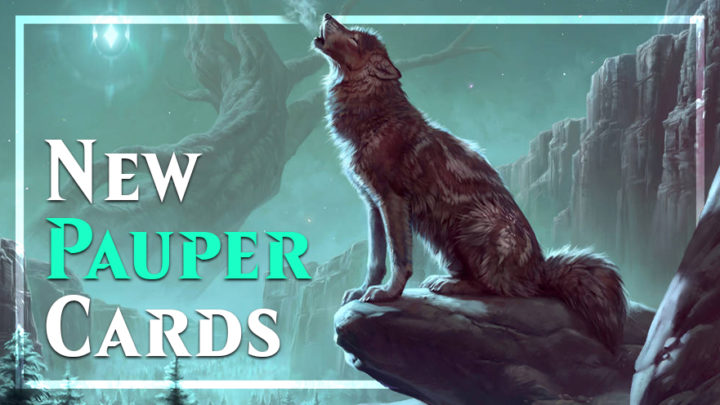With the new year comes a new preview season, and this one is a breath of fresh (or frosty) air! From Jimmy Wong channeling his inner metalhead to the return of the snow mechanic, the past week has been full of surprises in Magic. Kaldheim seems to have also flipped the script on what cards are previewed and when: there were a number of powerful commons shown alongside the set’s face mythics during the first preview show. This was a wonderful departure from the norm for us Pauper players!
My first impression of the commons that have been revealed so far was that they’re surprisingly powerful. Usually a set might have one new common that could see play in Pauper, but we’re less than one week into the preview season and I’ve already had my interest piqued by several cards! I’ll discuss each of them and their applications in detail, and what their impact might do to the format.
*Note: The Pauper metagame is currently dominated by Fall From Favor and Tron strategies, which have limited the number of viable decks at the highest tier of play. However, Gavin Verhey confirmed that there will be an evaluation of Pauper over the next while in the case of any issues, so we may see a rebalance in the format soon. Even so, I’d venture that many readers may not be interested in top-tier Pauper decks and just want to see what new decks are possible. I always stand by the statement that “Tier Fun is better than Tier One,” so play what makes you happy!
Snow Duals
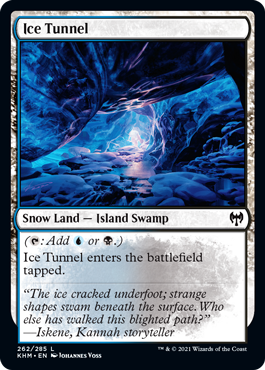
Snow basics have been the lands of choice for many decks in Pauper for a long time. Some decks, like Izzet Faeries, use them to power up Skred; others use them to bluff that they might have Skred (Mono-Blue Delver); and some previously used them as a flex prior to Modern Horizons’ reprints.
The Skred decks have been making use of Evolving Wilds, Terramorphic Expanse, and Ash Barrens for a long time; it’s important they have fixing while continuing to power up the removal spell. These snow duals should start to show up as ways to further fix their mana without sacrificing the number of snow permanents. This is quite a small impact from this cycle, however; the most important part is that they have basic land types.
Dimir Faeries currently runs few dual lands (if any at all), and the reason for this is Snuff Out. This removal spell serves as a critical piece of interaction while the deck enacts its own game plan. Current lands like Dismal Backwater don’t allow you to play Snuff Out for free, but Ice Tunnel will let Dimir have the shields up as early as turn one.
There are a number of cards that can ramp with these, too: Into the North can now grab any of these snow lands for even better fixing, and Farseek can do similar. Mwonvuli Acid-Moss can even fetch one of these, which is very relevant considering Gruul Ponza is a recent breakthrough deck!
Finally, the basic land typing is extremely relevant for decks that wish to run Utopia Sprawl and Arbor Elf. This means that Bogles and the aforementioned Gruul Ponza stand to benefit from this a little bit more than other decks. Any decks that don’t benefit from these effects shouldn’t swap out their duals just yet, however: the gain lands are better for decks that can’t make use of their new characteristics, as they provide a slight buffer against Burn.
Sarulf’s Packmate
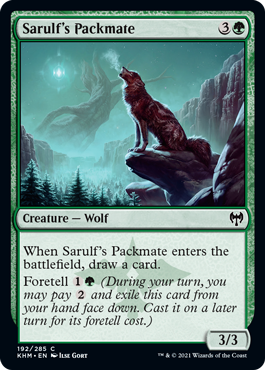
Three toughness used to be a big deal in Pauper; creatures in the format most commonly have two points of power, so the only real weakness for three toughness was that they died to Lightning Bolt. With more powerful removal than ever in Pauper (like Cast Down), the evaluation of a creature is less about their stats and more about the immediate value they provide. It’s one of the reasons why Augur of Bolas, Phyrexian Rager, and Sea Gate Oracle see play — they replace themselves, all while serving as good blockers or reasonable attackers.
Sarulf’s Packmate is the first of its kind: it’s got three points of toughness and more than one power, and it draws a card on ETB — all at a reasonable rate. This wouldn’t really be a decent choice if you had to spend four mana at once for it, but being able to pay for some of its cost on an earlier turn is more valuable than it initially seems.
This could make a strategy like Golgari Midrange more viable; Mono-Black Control is a deck that isn’t short of removal, but its creatures can be a bit mopey. Llanowar Visionary is already an upgrade over Phyrexian Rager, and this can replace the clunky top-end of Gray Merchant of Asphodel. What it loses in late-game reach, it gains in redundancy and flexibility.
Masked Vandal
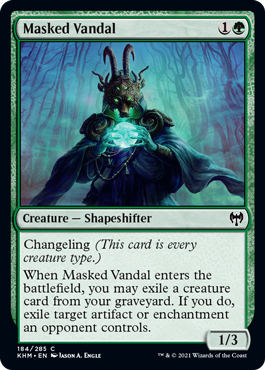
Reclamation Sage this is not, but that’s not necessarily a bad thing. There are no particularly effective creatures that can deal with artifacts or enchantments in Pauper, save for maybe Wickerbough Elder. There are plenty of Disenchant effects, but as the format is extremely combat-focused, it’d be much more beneficial to commit to the board at the same time.
Masked Vandal could find a forever home in Elves and even Slivers, but there’s one niche strategy that’s going to love it the most: Tortured Existence. The deck is essentially a Dredge control deck: it looks to sacrifice, loop, and dredge creatures to gain incremental advantage over its opponents. It’s never short of creatures in its graveyard, and powerful main deck hate for Affinity and Bonder’s Ornament will be extremely welcome.
Other decks that might look to add Masked Vandal include Mono-Black Zombies and Mono-Black Sacrifice. They are fringe but known decks that would easily be able to slow down and add a second color, in order to give them access to effects like this (and Weather the Storm/Gnaw to the Bone for Burn).
Behold the Multiverse
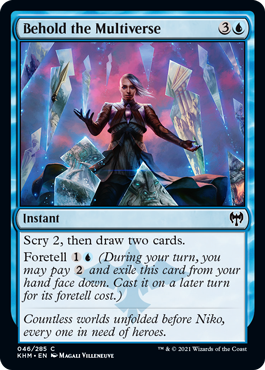
Blue is known for its ability to draw cards in every format, and Pauper is no different. Because of this, Behold the Multiverse is up against some stiff competition. Gush used to see extensive play before its banning, Accumulated Knowledge and Of One Mind have had their day in the sun, and now Frantic Inventory is the new hotness. There is one drawback to all of these cards that I never really liked: they all require setup in order to be decent.
Behold the Multiverse is in a league of its own for this reason; it’s more expensive, but foretell’s “pay in installments” plan is perfect for any draw-go control deck that wants to make sure it’s operating at maximum efficiency. An Izzet control deck can foretell this on turn three with a Lightning Bolt held up, then it can scry 2 and draw two cards on turn four with Counterspell backup, for example.
Frantic Inventory’s reliance on finding additional copies of itself can sometimes distract you from your game plan (choosing to draw a second copy of it with Preordain rather than digging for the answer you need, for example), but that’s not the case with Behold the Multiverse. It’s also perfectly fine to pay retail for what’s essentially a Pauper-legal Glimmer of Genius. I don’t expect it to have the same success as the other cards I mentioned, but I certainly wouldn’t count it out.
Ravenform
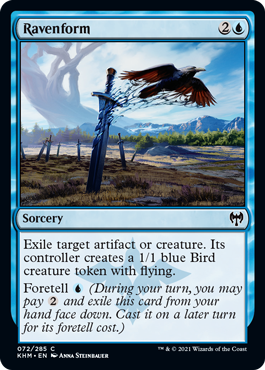
Blue rarely gets access to exile effects, and they’ve never been printed at common before. Mono-Blue tempo strategies have seen a resurgence lately, thanks to the power of Fall From Favor; even though that is the more powerful and flexible removal spell, I believe this will show up in some capacity.
Until now, the most effective way that blue strategies could deal with artifacts was to counter them as they were cast. Ravenform allows you to exile a Bonder’s Ornament, Gurmag Angler, or even Ulamog’s Crusher after the fact, which is a significantly more forgiving answer when it comes to timing. This is also a clean answer to Stormbound Geist, the mirror-breaker for most blue decks.
While there are some downsides to the card, they’re really not that bad. Three mana may be a lot for a removal spell, but foretell allows you to pay for it over two turns. Sorcery speed is also a huge downside, but it’s worth it for unconditional removal in blue. It won’t replace any removal, but it might either become a one-of in main decks, or replace Annul in sideboards. Naturally, Tron is likely the greatest benefactor for a spell like this.
While I’m actually most excited to try this out in Modern as a way to deal with Chalice of the Void, Ravenform will likely make a name for itself in the Pauper format.
As I said earlier, we’re not even halfway through Kaldheim preview season; there is still plenty of time to discover even more new Pauper-playable cards. If these are anything to go by, I’m anticipating an exciting few weeks ahead for the format!
What are your favorite new cards from Kaldheim so far? Let me know on Twitter!

Scott is an Irish content creator and the Head of Budget Magic for the Izzet League. He focuses on affordable decks in Pioneer, Modern, and Pauper, particularly ones that stray from the mainstream. When he’s not writing about his favorite decks, he can be found talking incessantly about them on Twitter and on The Budget Magic Cast.

